|
September 2014 - November 2014 |
| |
|
|
 |
|
 |
| |
Publisher: Chairman Gong-Ru Lin Editors: Professor
Chao-Hsin Wu, Ms. Hsiao-wen Lin January 30, 2015 |
| |
|
 |
|
Congratulations to GIPO professor Ching-Fuh Lin on his being awarded NTU’s “Outstanding
Research and Innovation Prize, 2014”.
Congratulations to the following GIPO students on their being awarded, under the directions of Professor Ching-Fuh Lin & Professor Gong-Ru Lin, the “2014 Youth Theses Prize of The Chinese Institute of Electrical Engineering”. The winners’ list is as follows:
The 2nd place:
|
Winner |
Adviser
|
Thesis title |
|
Pin-Chun Shen (Master student) |
Ching-Fuh Lin, professor |
Efficiently Luminescent Materials Based
on Semiconductor Nanostructures for
White-Light-Emitting Diodes |
The 3rd place:
|
Winner |
Adviser
|
Thesis title |
|
Min-Chi Cheng (Master student) |
Gong-Ru Lin, professor |
36 Gbit/s
16-QAM OFDM data transmission in
DWDM-PON with a directly modulated
and injection-locked WRC-FPLD
|
Congratulations to
I-Chung Chiu, a GIPO Ph.D. student, on his being awarded, under the direction of Professor
I-Chun Cheng, the “Best Doctoral Thesis Prize of Taiwan Institute of Electrical and Electronic Engineering”. For more information, please refer to the website:
http://www.tieee.org.tw/index.php/64-awards/awards-list/177-2014.
|
|
 |
|
 |
|
| |
|
 |
|
September “GIPO Colloquium” Highlights
(Compiled by Li-Chi Yao) |
|
|
4:30 pm, Sept. 19 (Fri.), 2014 |
|
Speaker: |
Professor Raphael Tsu (Dept. of Electrical and Computer Engineering, University of North Carolina, Charlotte) |
|
Topic: |
The Superlattice Story |
| |
Professor Raphael Tsu visited GIPO
on Sept. 19 (Fri.) and delivered a
speech concerning “The Superlattice
Story” at lecture theater 101, Barry Lam
Hall. His speech was informative and fascinating, and the professor interacted well with students; GIPO teachers and students attended the event with enthusiasm and benefitted a deal. |
| |
|
 |
|
A group photo of Professor
Raphael Tsu (2nd, right), Professor Hao-Hsiung Lin (1st, left), Professor Zhe-Chuan Feng (2nd, left) and the host of this speech Professor Chi-Kuang Sun (1st,
right) |
|
|
|
4:30 pm, Sept. 26 (Fri.), 2014 |
|
Speaker: |
Professor Tzung-Fang Guo (Graduate Institute of Photonics, National Cheng Kung University) |
|
Topic: |
Development and critical issue for organometal halide perovskite-based hybrid solar cells |
| |
Professor Tzung-Fang Guo visited GIPO on Sept. 26
(Fri.) and delivered a speech concerning “Development and critical issue for organometal halide perovskite-based hybrid solar cells” at
lecture theater 101, Barry Lam Hall. His speech was interesting and informative and the professor interacted well with students. GIPO teachers and students participated with enthusiasm and benefitted a great deal. |
|
|
|
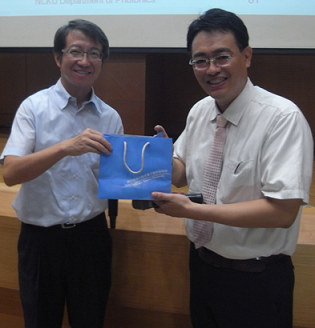 |
|
Professor Zhung-Fang Guo
(right), and the host of the speech, Professor Chi-Kuang
Sun (left) |
|
|
October “GIPO Colloquium” Highlights
(Compiled by Li-Chi Yao) |
|
|
4:30 pm, Oct. 3 (Fri.), 2014 |
|
Speaker: |
Professor Franz Kartner (MIT, EECS, University of Hamburg, Germany) |
|
Topic: |
An Orchestra of Light: Sub-Cycle Optical Waveform Synthesis and Controlled Electron Emission |
| |
Professor Franz Kartner visited GIPO on Oct. 3
(Fri.) and delivered a speech concerning “An
Orchestra of Light: Sub-Cycle Optical
Waveform Synthesis and Controlled Electron
Emission” at lecture theater 101, Barry Lam
Hall. His speech was fascinating and the professor interacted very well with students. GIPO teachers and students attended the event with enthusiasm and learned a great deal. |
|
|
|
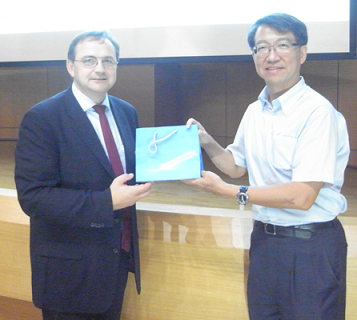 |
|
Professor Franz Kartner
(left), and the host of this speech,
Professor Chi-Kuang Sun (right) |
|
|
|
4:30 pm, Oct. 24 (Fri.), 2014 |
|
Speaker: |
Dr. Jyhpyng Wang (Institute of Atomic and Molecular Sciences, Academia Sinica) |
|
Topic: |
The principle and application of high intensity laser |
| |
Dr. Jyhpyng Wang visited GIPO on Oct. 24
(Fri.) and delivered a speech concerning “The principle and application of high intensity laser” at
lecture theater 101, Barry Lam Hall. His speech
was interesting and informative, and Dr. Wang interacted well with students. GIPO teachers and students participated with great enthusiasm and benefitted a great deal. |
|
|
|
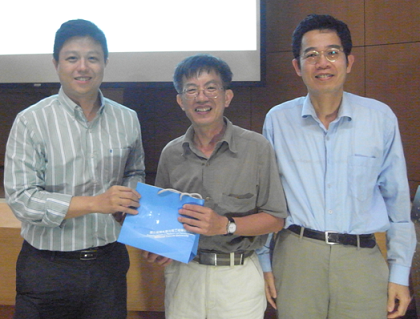 |
|
A group photo of Dr. Jyhpyng
Wang (middle), GIPO professor Chao-Hsin
Wu (left), and GIPO professor Lung-Han Peng
(right) |
|
|
|
4:30 pm, Oct. 31 (Fri.), 2014 |
|
Speaker: |
Professor Jean-Louis Coutaz (University of Savoie, France) |
|
Topic: |
Terahertz Optoelectronics: Basics, Technology and Applications |
| |
Professor Jean-Louis Coutaz visited GIPO
on Oct. 31 (Fri.) and delivered a speech concerning “Terahertz
Optoelectronics: Basics, Technology and
Applications” at lecture theater 101,
Barry Lam Hall. The professor’s speech was informative and interesting and he interacted well with students. GIPO teachers and students participated in this event with enthusiasm and learned a great deal. |
| |
|
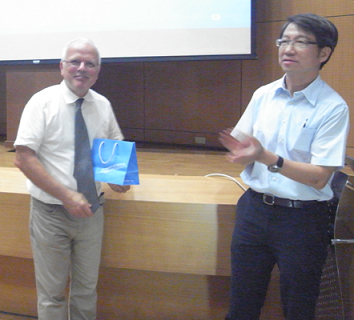 |
|
Professor Jean-Louis Coutaz
(left), and the host of the speech,
Professor Chi-Kuang Sun (right) |
|
|
~ The self-introduction of the President of GIPO Student Association, 2014 academic year
~
Composed by
Yu-Hsiang Su, the President of GIPO Student Association
 Hello, GIPO teachers, staff and students, I’m Yu-Hsiang Su, the new president of GIPO Student Association. The association has played an important role in promoting student rights and improving teacher-student relationships; therefore, I’m deeply honored to be the president and serve the Institute. I would like to thank professor Chi-Kuang Sun for his support of my involvement in the association’s affairs, senior colleague Ting-Hao for his instruction and support, and GIPO office staff for their assistance and advice. Hello, GIPO teachers, staff and students, I’m Yu-Hsiang Su, the new president of GIPO Student Association. The association has played an important role in promoting student rights and improving teacher-student relationships; therefore, I’m deeply honored to be the president and serve the Institute. I would like to thank professor Chi-Kuang Sun for his support of my involvement in the association’s affairs, senior colleague Ting-Hao for his instruction and support, and GIPO office staff for their assistance and advice.
The motive of attending a graduate institute is different from that of attending an undergraduate college. It is a decision after deliberate considerations of career investment. Graduate students are striving toward studies for interests, breakthroughs and future occupational development. They spend almost all of their time doing research. While reflecting on their hard work and being proud of their achievements, students also wish to add some vivid memories of these times. Except a few rare gatherings with friends, they seldom have any time to spend on other social events. I think it’s a pity to have no sense of belonging at GIPO. Therefore, this association will hold several events to bring fun to students and encourage them to interact. While enjoying delicious food and interesting shows during meals, or competing in sports games and winning prizes, students will find opportunities to get to know one another . We aim to make GIPO more than just a place of study, but also a place of warm happiness which they will remember long into the future.
During GIPO meetings and participations with graduate student associations, we will work to ensure that student scholarships and rights are properly handled. We also believe many students have interesting ideas that they would like to share, and we would be very happy to hear those suggestions. How exciting it is to work together to improve everyone’s life at GIPO! If you have ideas, and want to be a part of the change, we are excited to have you join us. We know all of the students, new and old, have expectations for GIPO; you are all welcome to drop by for a chat anytime. We want the association to help create wonderful memories for all of you!
|
~ A small-scale emergency drill of GIPO laboratories ~
(Time: 11:00 ~ 11:20
am, Sept. 22, 2014;Location: Room 101, EE-1 Building)
Composed by
Tzu-Yu Chen
The drill:
The purpose of this drill is to enhance participants’ knowledge of how to escape and strengthen their capability of coping with emergencies. This ensures everyone understands their duties at such a time and takes proper measures to minimize damage.
The drill
took place in lab 101 of EE-1 Building, where a toxicant chemicals’ lab supposedly caught fire during a students’ experiment. The students reported the incident to GIPO office and broadcast it to the entire hall to evacuate personnel immediately. GIPO staff then called every hall and department to help with the evacuation. The latter then sent rescue teams to each exit to direct people leaving their buildings, help control the damage and extinguish the fire. They also set up “no entrance” signs, prepared a first aid station to treat wounded students, and checked the number of the evacuated personnel at the assembling area. Meanwhile, GIPO staff also called Professor Lon
A. Wang, the professor in charge of
the laboratory, Professor Gong-Ru Lin, GIPO chair, Professor Jian-Jang Huang, GIPO
vice chair, and Professor Jui-Che Tsai, GIPO environment protection, occupational safety, and health commissioner, to meet at EE-1 Building square. GIPO chair,
vice chair and the commissioner then gave orders accordingly to cope with the situation. After having made sure that all laboratory personnel had been safely evacuated, the drill was then successfully completed.
This drill had strengthened our ability to report an incident and evacuate in a timely manner during emergencies. We would like to thank the professors, staff, and students for your cooperation.
Suggestions for improvement:
As EE office staff were broadcasting, people in laboratories were unable to hear the announcement. The broadcasting system may require tests and repairs. We would also suggest that each floor be equipped with its own broadcasting systems, so that once an emergency has occurred on a floor other than the 1st, someone reporting an incident could use the system on their own floor instead of running to the 1st floor.
|
 |
 |
|
The reporting staff of lab 101, EE-1
Building. |
GIPO office staff calling EE department staff and other relevant personnel for help. |
|
 |
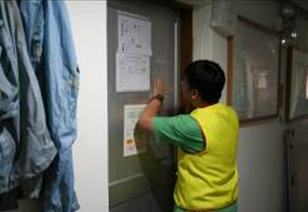 |
|
The student of the lab on fire broadcasting the emergency. |
The student of the lab on fire knocking at doors of other nearby labs to give notice of the fire. |
|
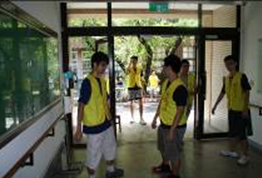 |
 |
|
Helpers were organized and sent to the scene. |
Helpers were directing persons to evacuate. |
|
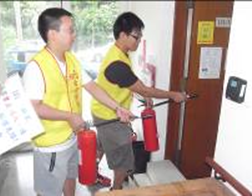 |
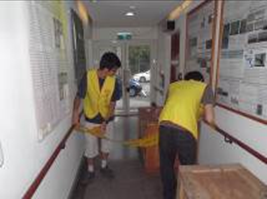 |
|
Helpers extinguishing the fire. |
Setting up “no entrance” signs. |
|
 |
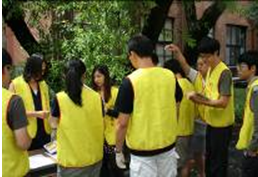 |
|
Setting up first-aid stations and treating wounded students. |
All persons evacuating to the assembling area and counted. |
|
 |
|
 |
|
| |
|
 |
|
~
2014 Ph.D. Student Academic Exchange with Nanjing University
~
(The 7th
Cross-Strait Ph.D. Student Forum on Photonic Science and Technology, 2014)
(Time: Sept. 28 ~ Oct. 4, 2014;
Location:
National Taiwan University)
Composed by
Tsung-Chin Cheng,
GIPO Ph.D. student and the captain of
GIPO student team
A major GIPO annual event, the 7th Cross-Strait Ph.D. Student Forum on Photonic Science and Technology 2014 has been held at EECS’s most luxurious meeting place – Barry Lam
Hall. Nanjing University sent 21 teachers and students, including Shining Zhu, a NU Physics College professor and a Chinese Academy of Sciences’ academician, and
Xinglong Wu, a NU deputy dean, to Taiwan to exchange ideas with GIPO teachers and students and visit business and culture interests.
The forum began with Professor Sy-Yen Kuo, the dean of EECS, NTU, introducing NTU’s history and EECS’ profile. Next, NU’s
Academician
Shining Zhu, Deputy Dean
Xinglong Wu, Chairman
Qing Bian, and GIPO Chair Gong-Ru Lin addressed the forum respectively. Next, the agenda of the forum followed.
In invited talks, Academician
Shining Zhu showed us some of his research and his study of the diffraction structure in optics, which interested me very much. He also spent some time discussing the possibility of applying the aforesaid studies to quantum computers; I am eagerly anticipating the development of this technology.
In next day’s invited talk, GIPO
vice chair, Professor Jian-Jang Huang, delivered a lecture concerning “IGZO thin film transistor and their applications to biosensing”. The professor’s talk illustrated the advantage in characters of using IGZO in transistors and explained clearly the definition and principle of each parameter. Professor Huang’s lecture gave me a deeper understanding of IGZO elements. The professor also shared with us his lab’s study of the application of IGZO TFT in biosensing, and explained to us the method of using this technology to detect cancers in 3 minutes. This topic attracted fervent discussion among teachers and students, and I learned a great deal.
The forum was divided into 8 topics: surface plasma, LED & solar cell, device, micro/nano physics, graphene, optoelectronic material, periodic structure, and optics. Each Ph.D. student had 20 minutes to deliver a report and 5 minutes for questioning. There were 11 NTU Ph.D. students and 15 NU Ph.D. students making reports.
The reporting students who impressed me the most were NU’s
Xiaochen Sun, Chunxiong Bao and NTU’s Chia-Ying Su.
Chia-Ying Su’s study was “Strain reduction and crystal improvement of an InGaN/GaN quantum-well light emitting diode on patterned Si(110) substrate”, which was quite new and unique. She had not only successfully used MOCVD to make QW-LED, but also achieved fairly good detected results in IQE and XRD characters. Moreover, her confidence and clear logic in reporting made quite an impression on me.
I was also very interested in NU’s
Chunxiong Bao’s report. He used nanowire to make transparent conducting electrode, and successfully used it in touch panel technology. It happened that touch panel technology was also one of my specialties; therefore, during the intermission, we spent some time further discussing the techniques that he developed.
|
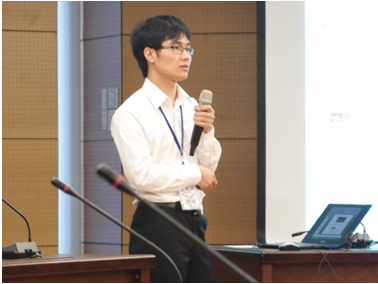 |
There was one more student who impressed me very much was
Xiaochen
Sun, a student of National Laboratory of
Microstructure of the School of Contemporary
Engineering and Applied Science, Nanjing
University. His report explored the photonic
analogue of quantum spin gall effect. His clear enunciation, steady reporting rhythm, and occasional interesting slides as reporting aids attracted my attention from the very beginning to the last.
He started from photonic crystals theory to its relationship with quantum spin gall effect, and then brought up a question which needed everyone’s contemplation: “Is it still time inversion symmetry when something has already provided symmetry protection?” Next, he used quantum mechanics’ matrix operation to complete the whole simulation and explanation. At the last, he developed the counterfeit time inversion symmetry in symmetry and parameter design theories, and thereupon designed the photonic crystals.
|
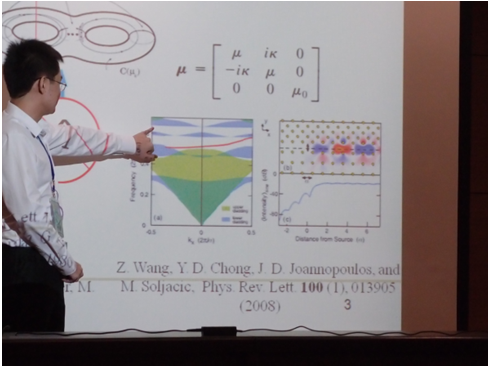 |
Finally, the 2-day forum drew to a close after those wonderful reports, and not surprisingly, NTU’s
Chia-Ying Su’s and NU’s
Xiaochen Sun’s outstanding reports were honored the best theses of this forum.
Time went by quickly on the 2-day forum. Nevertheless, through this valuable opportunity to exchange ideas and research with one of the Mainland’s best universities had left a deep impression on me and inspired many new thoughts and ideas.
|
|
 |
|
 |
|
| |
|
 |
IGZO Thin Film Transistor Biosensors Functionalized with ZnO Nanorods and Antibodies
Professor Jian-Jang Huang's laboratory
Graduate Institute of Photonics and
Optoelectronics, National Taiwan University
We demonstrate a biosensor structure consisting of an IGZO (Indium-Gallium-Zinc-Oxide) TFT (thin film transistor) and an extended sensing pad. The TFT acts as the sensing and readout device, while the sensing pad ensures the isolation of biological solution from the transistor channel layer, and meanwhile increases the sensing area. The biosensor is functionalized by first applying ZnO nanorods to increase the surface area for attracting electrical charges of EGFR (epidermal growth factor receptor) antibodies. The device is able to selectively detect 36.2 fM of EGFR in the total protein solution of 0.1 ng/ml extracted from squamous cell carcinoma (SCC). Furthermore, the conjugation duration of the functionalized device with EGFR can be limited to 3 minutes, implying that the biosensor has the advantage for real-time detection.
|
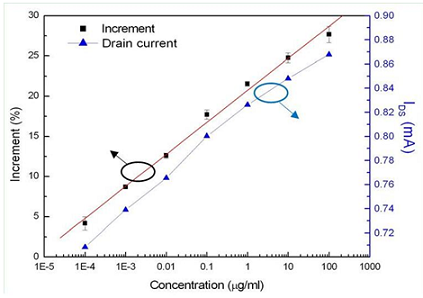 |
|
Figure 2 Electrical properties of the biosensor. The corresponding drain currents and current increments at various total protein concentrations are demonstrated. |
All-optical switching in GaAs microdisk resonators by a femtosecond pump-probe technique through tapered-fiber coupling
Professor Ming-Hua Mao's laboratory
Graduate Institute of Photonics and
Optoelectronics, National Taiwan University
We demonstrate ultrafast all-optical switching in GaAs microdisk resonators using a femtosecond pump–probe technique through tapered-fiber coupling. The temporal tuning of the resonant modes resulted from the refractive index change due to photoexcited carrier density variation inside the GaAs microdisk resonator. Transmission through the GaAs microdisk resonator can be modulated by more than 10 dB with a switching time window of 8 ps in the switch-off operation using pumping pulses with energies as low as 17.5 pJ. The carrier lifetime was fitted to be 42 ps, much shorter than that of the bulk GaAs, typically of the order of nanoseconds. The above observation indicates that the surface recombination plays an important role in increasing the switching speed. This work has been published in Optics Letters, Vol. 39, No. 17, pp. 4998, (2014).
|
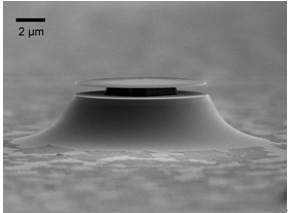 |
|
Fig. 1. Scanning electron microscope image of the fully processed microdisk cavity with a diameter of 10 μm. |
|
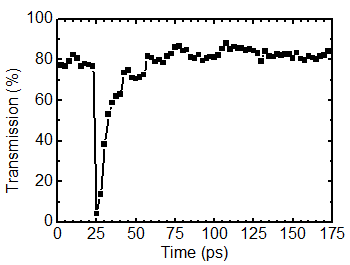 |
|
Fig. 2. Switch-off dynamics with modulation depth more than 10 dB. |
Very Closely Located Dual-band Frequency Selective Surfaces via Identical Resonant Elements
Professor Yih-Peng Chiou's laboratory
Graduate Institute of Photonics and
Optoelectronics, National Taiwan University
Very closely located dual-band frequency selective surfaces (FSSs) are proposed. The ratio of two operating bands can be as low as 1.06. The proposed FSSs comprise simply a single-layer metallic pattern on a thin dielectric substrate. The mechanism to achieve the low ratio between two operating bands is attributed to two separated resonant modes caused by four identical elements in a unit cell. Asymmetrical meandered pattern is introduced to improve stability of frequency responses with respect to incident angles. Moreover, the ratio of the operating bands can be tuned through rotation of the elements with ratios in the range from 1.06 to 1.10. In order to validate the designs, the prototype of the dual-band FSSs has been fabricated and tested. And the measured results show good agreements with the simulated ones. This work is submitted to IEEE Antennas and Wireless Propagation Letters and accepted for publication.
 |
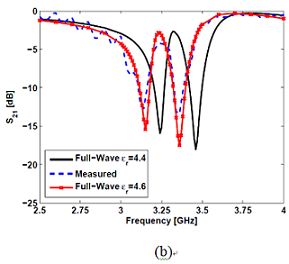 |
|
Fig. 1. (a) The prototype of proposed very closely located dual-band FSSs, comprising a single layer metallic elements of 0.357 mm linewidth on a 0.23 mm FR4 substrate (ϵr = 4.4, loss tangent=0.02) with periodicity of 20 mm. The size of the prototype is 840 mm× 580 mm. (b) The measured S21 of the prototype along with the full-wave results which FSSs with 0.23 mm FR4 substrate of ϵr = 4.4 and ϵr = 4.6 (loss tangent=0.02) are simulated, respectively. |
Simulating an optical target to eliminate impinging beam in a light scattering simulations
Professor Snow H. Tseng's laboratory
Graduate Institute of Photonics and
Optoelectronics, National Taiwan University
In a light scattering simulation, light impinging
upon the target position needs to be appropriately eliminated or else the
continuously impinging light becomes a source of noise as it further
reverberates through the random media. We report an optical target that
eliminates incident waves to drain out the incoming energy. We show that the
proposed optical target can absorb impinging light upon it from arbitrary
directions. The performance of the optical target is analyzed and discussed.
|
 |
|
Fig. Displacement of the CPML absorber causes imperfect elimination of the incident wave. An isotropic converging circular wave with the CPML displaced by various distances is simulated: (a) 0 μm, (b) 1 μm, (c) 4 μm from the center. The elimination effectiveness depends on the displacement. The error as a function of displacement is shown in (d). |
Wide-angle and ultra-thin camera module using a curved hexagonal microlens array and all spherical surfaces
Professor Guo-Dung J. Su's laboratory
Graduate Institute of Photonics and
Optoelectronics, National Taiwan University
We propose a wide-angle and thin camera module
integrating the principles of an insect’s compound eye and the human eye,
mimicking them with a curved hexagonal microlens array and a hemispherical lens,
respectively. Compared to typical mobile phone cameras with more than four
lenses and a limited full field of view, the proposed system uses only two
lenses to achieve a wide full field of view. Furthermore, the thickness of our
proposed system is only 2.7 mm. It has an f-number of 2.07, an image diameter of
4.032 mm, and a diagonal full field of view of 136°. The results showed good
image quality with a modulation transfer function above 0.3 at a Nyquist
frequency of 166 cycles/mm. This work has been published in Applied Optics, Vol.
53, Issue 29, pp. H121-H128 (2014).
|
 |
|
Fig.1 Oblique view of curved hexagonal MLA. Each lens diameter is 500 μm, and the substrate radius is 2 mm. |
|
 |
|
Fig.2 Image simulation and processing of whole CMOS sensor. |
|
|
|
 |
|
 |
|
| |
|
|
 |
|
 |
|
|
|